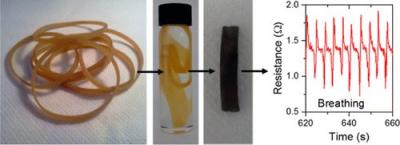The Graphene-Info newsletter (September 2014)
Published: Tue, 09/02/14
Graphene alternatives |
Following the hype, research activity and money following graphene in past years, many researchers are turning their attention towards alternative materials similar to graphene. In the past few weeks, two related interesting research papers were published.
The first paper comes from the University of Alberta, and reports that hemp fibers (first discussed in 2013) may be as efficient as graphene as supercapacitor electrodes. Those electrodes are made from bio waste in a simple process, and are much cheaper than graphene based electrodes.
The Second paper, from Seoul National University, discusses a one-step method to prepare a carbon material, called NCF, from used cigarette filters. They used the NCF to create supercapacitor electrodes - which exhibit a better rate capability and higher specific capacitance than even CNT or graphene based electrodes.
Graphene-coated rubber bands for wearable sensors |
Researchers from Trinity College in Ireland developed wearable sensors by coating simple rubber bands with graphene. The idea is that the rubber band changes its electric conductivity when it stretches - so even tiny movements (such as breathing or pulse) can be sensed. Such sensors can also be used in the automotive industry, robotics, medical devices and more.
The researchers say that their method is simple and compatible with normal manufacturing techniques. The basic material (rubber) is very cheap of course.
Tesla's graphene-enhanced battery rumor |
Tesla's current Model S car has batteries with a capacitance of 85 kWh, which enables the car to drive up to 480 km between charges. The company's CEO, Ilon Mask, recently said that the company is developing "new battery technology" that will almost double the capacity, and a report from China suggests that Tesla's new battery technology is based on graphene.
This report makes sense as graphene-based battery electrodes can dramatically increase battery charge time and capacity, and it seems that the technology is indeed on the verge of commercialization. There are many companies developing this technology and it's likely that Tesla is collaborating with one (or more of these companies).
In 2013, XG Sciences launched a new graphene-based anode materials for Li-Ion batteries that has four times the capacity of conventional anodes. XGS says that the new material is available today at commercial scale with an "attractive pricing". In 2014, SiNode Systems signed a joint-development agreement with Merck's AZ Electronic Materials with an aim to commercialize graphene-based materials for lithium-ion batteries.
Angstron Materials recently launched a line of graphene-enhanced anode materials for lithium-ion batteries, called "NANO GCA", which combine high capacity silicon materials with mechanically reinforcing, and electrically conductive graphene.
Other companies developing graphene-enhanced batteries include Perpetuus, CalBattery, Graphene Batteries and others.
Tesla is collaborating with Panasonic to build the world's largest Li-Ion battery plant (the Gigafactory) - that by 2020 will produce more Li-Ion batteries annually than were produced worldwide in 2013. This should price battery prices down by more than 30%, according to Tesla.
Graphene 3D Labs now trades in the TSX |
Graphene 3D Lab is the latest pure-play graphene company to go public, as it now trades in the Canadian TSX stock exchange under the ticker GGG, following the company's reverse-merger with Matnic Resources (whose previous ticker was MIK.V).
Graphene 3D Lab is a joint-venture between Graphene Labs and Lomiko Metals. The company focuses on the development of high-performance graphene-enhanced materials for 3D Printing. Lomiko Metals holds 15% of Graphene 3D Lab (4.4 million shares). Graphene 3D Labs is not alone in graphene-based 3D printing research - in past month we've seen many companies involved in this field, including Graphene Technologies, Grafoid, AGT, Kibaran, Qingdao Unique Products and others.
Top Graphene News |
Holey graphene enables highest density capacitors
A new graphene-based material can can significantly enhance the energy density of supercapacitors - in fact making them as good as lead acid batteries.
NUS launches a new 2D materials center
The National University of Singapore will open a new 2D materials research center, with $40 million in funding in the next 10 years. The NUS Graphene Research Center will become a part of this new center.
$880,000 towards graphene-based DNA sequencing
The National Institutes of Health awarded a $880,000 grant for a University of Pennsylvania 2-year project that aims to develop fast and cost-effective genome sequencing, using graphene membranes.
Graphene-based wearable vapor sensors
Those graphene sensors can be used for continuous disease monitoring, for diabetes, high blood pressure, anemia or lung disease.
Graphene Frontier's G-FET sensors explained
Last month Graphene Frontiers launched their Six-Sensors brand for highly-sensitive chemical and biological GFET-based sensors. We posted an article explaining this interesting new sensor platform.
Graphene springs
Researchers from China developed graphene-based springs that can function as actuators. Those springs are very light and offer good thermal and electrical conductivity. They are also easy to functionalize and work in harsh conditions.
New method to produce defect-free graphene
Researchers at from Korea's KAIST institute developed a new method to fabricate defect-free graphene. Using this graphene, they developed a promising high-performance anode for Li-Ion batteries.
SiNode and Merck's AZ Electronic Materials graphene co-development project
SiNode Systems signed a joint-development agreement with Merck's AZ Electronic Materials with an aim to commercialize graphene-based materials for lithium-ion batteries.
Send this to a friend |
Do you have a friend or a colleague that might be interested in Graphene technology? Forward this mail to update him on the
world of Graphene.
If you received this email from a friend, subscribe to this
newsletter here!





